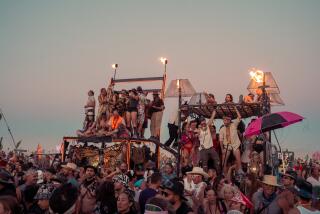Holding on to Downey’s place in the space race
- Share via
Gerald Blackburn walked out of his office and surveyed the ruins of what was once the nerve center of America’s space race.
The vast debris field with giant cranes nosing through heaps of broken concrete and metal sheeting had been home to the Downey Industrial Site, a 160-acre campus southeast of Los Angeles where engineers like Blackburn designed the spacecraft that put Americans on the moon.
The largely abandoned buildings were leveled over the holidays to make way for a big-box retail center.
“Unfortunately this is the view of what’s left,” Blackburn said.
Blackburn is disheartened not just by the demolition but the lack of regard for the legacy of the Downey Plant. From the 1960s to the 1990s, tens of thousands of engineers and technicians built the Apollo modules, and then designed and supervised assembly of the space shuttle fleet.
Blackburn, who worked 35-plus years at the Downey Plant as a technician, systems engineer and project manager, said the history is vanishing with the buildings. He tried not to watch as the structures came down.
Dressed in a Hawaiian shirt and khakis, the bearded Blackburn looks younger than his 68 years. Growing up in the Lynwood/South Gate area, Blackburn was a “garage tinkerer” who started working at the Downey Plant straight out of Don Bosco Technical Institute, a Roman Catholic high school in Rosemead.
It was a time of challenge and excitement, he said. “We would get up in the morning wondering what new problem there was to solve,” Blackburn said. “The nation called us and we responded.”
It was also a time of sacrifice; marriages crumbled, and Blackburn lost sight in one eye in a testing accident.
Blackburn runs a volunteer group, the Aerospace Legacy Foundation, out of the last original building of significance at the plant site, an Art Deco timber-and-beam structure designed by Gordon Kaufman, architect of the Hoover Dam and the Los Angeles Times building.
His offices are filled with memorabilia from what he calls the “Cosmic Camelot” years. A photograph on one wall shows women at the assembly line in high-rise trousers and pinned-up hair. During World War II, tens of thousands of workers at the Downey Plant built training planes for the military.
A panel from the Apollo 13 moon capsule is mounted with a plaque signed by the crew, thanking Downey workers for getting them home safely. “That’s one of our treasures,” Blackburn said. By the back door is a wooden cutout of the Snoopy cartoon character dressed as an astronaut labeled in peeling paint, “Next Launch Date.” The sign was used to announce missions, he said.
After the space shuttle program wound down, the city of Downey bought the site from the federal government and turned part of it into a movie production facility. Major films like “Spider-Man” were made at Downey Studios.
But advances in movie technology and runaway production eliminated the need for big sound stages, and the facility shut down, Blackburn said.
The city heavily courted Tesla Motors to replace film production with electric car manufacturing. For a full-page newspaper advertisement, the entire Downey City Council dressed up in “Downey [Heart] Tesla” T-shirts, holding a banner that read “Apollo to Tesla … the legacy continues.”
But in 2010, Tesla decided to move into an old Toyota factory in Fremont in the Bay Area.
Many people in Downey were deeply disappointed, Blackburn said, when the City Council in January approved plans for the 77-acre big-box center “Tierra Luna Marketplace.”
“Everybody’s reaction was this development seems so short-sighted,” Blackburn said. “Can’t you do better?”
There’s already a shopping center on the former plant site, Downey Landing. A sports park, a Kaiser Permanente hospital and a small museum called the Columbia Memorial Space Center are also on the grounds. The space center honors the crew of the space shuttle Columbia, which broke apart on reentry in 2003, killing all seven on board.
Although Downey has managed to save the first Taco Bell and the first McDonald’s arch, all that’s left at the Downey Plant to honor the men and women who worked on the space program, aside from the aerospace legacy’s collection and efforts, are a few plaques and artwork, Blackburn said.
“It’s a very small token of 80 years of history that happened here,” he said.
Blackburn had hoped there could be a tie-in event at the Downey Plant to the ballyhooed journey last September of the space shuttle Endeavour to its retirement berth in Exposition Park. It didn’t happen.
A full-scale shuttle mock-up that Downey workers built in the 1970s to land the space shuttle contract survived the plant’s destruction. Blackburn and the city would like to see it on display for visitors. But the city is still looking for money to build a permanent home for the mock-up.
So while crowds lined up 10 deep on sidewalks to watch the Endeavour overhead, the mock-up sat under lock and key in a white tent next to the Columbia Memorial Space Center. The Endeavour flew over the 5 Freeway in the vicinity of Downey, but only because it was on its way to Disneyland, Blackburn said.
Blackburn said he is developing a virtual tour of the Downey Plant for smartphones that visitors could view as they walk through the old grounds. He is also hoping to team with some of the other aerospace pioneers and companies to commemorate and preserve their joint history.
“The story has not been told of the men and women of this nation and this community that built the most incredible and complex machines in the history of mankind,” Blackburn said.
More to Read
Sign up for Essential California
The most important California stories and recommendations in your inbox every morning.
You may occasionally receive promotional content from the Los Angeles Times.










